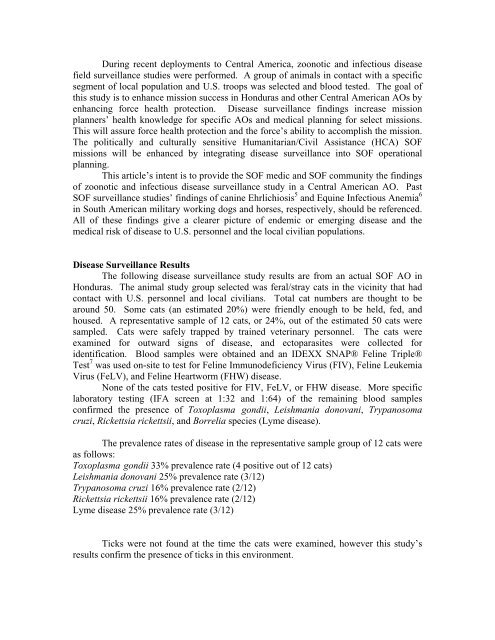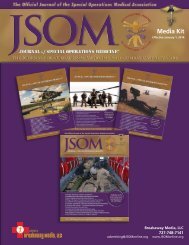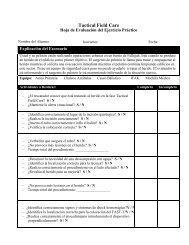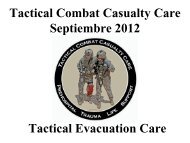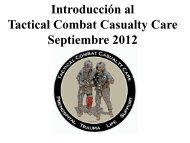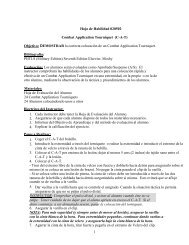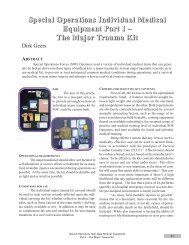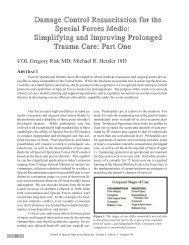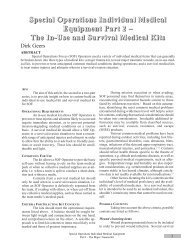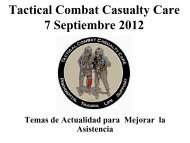During recent deployments to Central America, zoonotic <strong>and</strong> infectious diseasefield surveillance studies were performed. A group of animals in contact with a specificsegment of local population <strong>and</strong> U.S. troops was selected <strong>and</strong> blood tested. The goal ofthis study is to enhance mission success in Honduras <strong>and</strong> other Central American AOs byenhancing force health protection. <strong>Disease</strong> surveillance findings increase missionplanners’ health knowledge for specific AOs <strong>and</strong> medical planning for select missions.This will assure force health protection <strong>and</strong> the force’s ability to accomplish the mission.The politically <strong>and</strong> culturally sensitive Humanitarian/Civil Assistance (HCA) SOFmissions will be enhanced by integrating disease surveillance into SOF operationalplanning.This article’s intent is to provide the SOF medic <strong>and</strong> SOF community the findingsof zoonotic <strong>and</strong> infectious disease surveillance study in a Central American AO. PastSOF surveillance studies’ findings of canine Ehrlichiosis 5 <strong>and</strong> Equine <strong>Infectious</strong> Anemia 6in South American military working dogs <strong>and</strong> horses, respectively, should be referenced.All of these findings give a clearer picture of endemic or emerging disease <strong>and</strong> themedical risk of disease to U.S. personnel <strong>and</strong> the local civilian populations.<strong>Disease</strong> Surveillance ResultsThe following disease surveillance study results are from an actual SOF AO inHonduras. The animal study group selected was feral/stray cats in the vicinity that hadcontact with U.S. personnel <strong>and</strong> local civilians. Total cat numbers are thought to bearound 50. Some cats (an estimated 20%) were friendly enough to be held, fed, <strong>and</strong>housed. A representative sample of 12 cats, or 24%, out of the estimated 50 cats weresampled. Cats were safely trapped by trained veterinary personnel. The cats wereexamined for outward signs of disease, <strong>and</strong> ectoparasites were collected foridentification. Blood samples were obtained <strong>and</strong> an IDEXX SNAP® Feline Triple®Test 7 was used on-site to test for Feline Immunodeficiency Virus (FIV), Feline LeukemiaVirus (FeLV), <strong>and</strong> Feline Heartworm (FHW) disease.None of the cats tested positive for FIV, FeLV, or FHW disease. More specificlaboratory testing (IFA screen at 1:32 <strong>and</strong> 1:64) of the remaining blood samplesconfirmed the presence of Toxoplasma gondii, Leishmania donovani, Trypanosomacruzi, Rickettsia rickettsii, <strong>and</strong> Borrelia species (Lyme disease).The prevalence rates of disease in the representative sample group of 12 cats wereas follows:Toxoplasma gondii 33% prevalence rate (4 positive out of 12 cats)Leishmania donovani 25% prevalence rate (3/12)Trypanosoma cruzi 16% prevalence rate (2/12)Rickettsia rickettsii 16% prevalence rate (2/12)Lyme disease 25% prevalence rate (3/12)Ticks were not found at the time the cats were examined, however this study’sresults confirm the presence of ticks in this environment.
DiscussionIn the current austere Central <strong>and</strong> South American areas that SOF medics aredeployed, the living conditions <strong>and</strong> close quarters set a prime environment for the spreadof a variety of diseases, potentially these zoonotic diseases. The initial signs <strong>and</strong>symptoms of some of these zoonotic diseases can be similar to the usual symptoms of asick teammate. These symptoms include headache, general malaise, diarrhea, dermatitis(i.e., rash), nausea, fever <strong>and</strong> vomiting, all of which a SOF medic commonly blame onthe local water supply or food preparation. Given the results of the study, the SOF medicmust see the value of disease surveillance testing in animals. The SOF medic can test thedomestic animals near the detachment’s living quarters with the IDEXX Feline <strong>and</strong>Canine SNAP® Tests <strong>and</strong> the USACHPPM Tick Test Kits at the beginning of thedeployment to get an estimate on possible ectoparasites or zoonotic infectious diseases inthe area. This information will give the SOF medic a h<strong>and</strong> in developing a differentialdiagnoses for future treatments of teammates while deployed, especially in remote areaswhere sending blood off to be cultured or tested is a complicated endeavor.The parasitic protozoon, Toxoplasma gondii, is the causative agent forToxoplasmosis. The SOF medic should be aware that Toxoplasmosis is implicated incausing fetal death in pregnant women <strong>and</strong> serious effects to an immunocompromisedperson.T. gondii tissue cysts are ingested by a cat, the definitive host, when feeding oninfected small animals such as rodents. T. gondii oocysts are then shed in the cat’s feces.Other animals <strong>and</strong> humans may become infected after ingesting these oocysts. 8 This mayoccur when eating improperly washed fruits/vegetables, when eating improperly cookedmeats, or in cases of poor hygiene. Pregnant women should be advised not to clean catlitter boxes due to the potential for fecal-oral transmission. The SOF medic has theopportunity to educate U.S. personnel as well as a local civilian community on improvingpersonal hygiene (proper h<strong>and</strong> washing) <strong>and</strong> prevention of this disease.Trypanosoma cruzi is the parasitic causative agent for Trypanosomiasis diseasesin humans <strong>and</strong> animals. The Reduviidae bug vector deposits feces on the skin of ananimal or human <strong>and</strong> then bites. The host then scratches the superficial bite areaallowing penetration of the infected feces. 9 The SOF medic must be aware that HumanAmerican Trypanosomiasis, also known as Chagas disease, is a very prevalent disease inCentral <strong>and</strong> South American <strong>and</strong> is known to have fatal consequences.The protozoon, Leishmania donovani, is the causative parasite for Leishmaniasis.Spread through the cutaneous bites of s<strong>and</strong> flies, the three types of Leishmaniasis are10Cutaneous, Mucocutaneous, <strong>and</strong> Visceral Leishmaniasis.Rickettsia rickettsii is the bacterium responsible for Rocky Mountain SpottedFever. This bacterium is passed to humans <strong>and</strong> animals through the bites of Dermacentor11species ticks, serving as both reservoirs <strong>and</strong> vectors.Borrelia burgdorferi is the causative bacterium responsible for Lyme disease,12passed through the bite of the Ixodes species tick (deer tick), the primary tick vector.Along with animal blood testing, concurrent ectoparasite surveillance, sampling,<strong>and</strong> identification provide useful information to mission <strong>and</strong> medical planners. The U.S.Army Center for Health Promotion <strong>and</strong> Preventive Medicine (USACHPPM) Tick TestKits are now available [USACHPPM is now the U.S. Army Public Health Comm<strong>and</strong>


